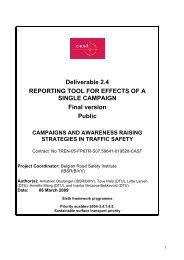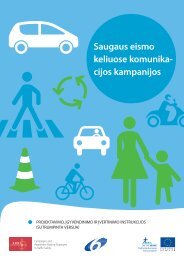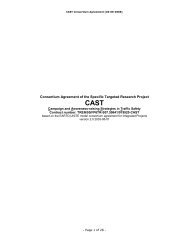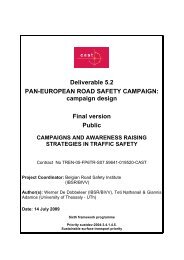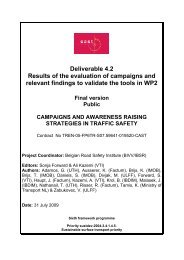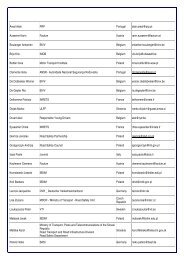Deliverable D 1.3 RESULTS OF META-ANALYSIS ... - cast-eu.org
Deliverable D 1.3 RESULTS OF META-ANALYSIS ... - cast-eu.org
Deliverable D 1.3 RESULTS OF META-ANALYSIS ... - cast-eu.org
Create successful ePaper yourself
Turn your PDF publications into a flip-book with our unique Google optimized e-Paper software.
Campaigns and awareness raising strategies in traffic safety — <strong>Deliverable</strong> D-1.18. MODEL <strong>OF</strong> FACTORS INFLUENCING CAMPAIGN EFFECT8.1 <strong>META</strong>-REGRESSIONUp to now we have described the use of meta-analysis to generate asummary of the overall effects of road safety campaigns on beliefs,knowledge, different types of behaviour and accident counts. Since there weresufficient numbers of effects in the database, we divided each group ofaccident count and seatbelt use effects into sub-groups according to variablesdescribing study background, and campaign delivery and content. We thenused meta-analyses to summarize the effects in each of these subgroups,after adjusting for publication bias.The aim of the sub-group analysis is to give a realistic idea about the overallsize of campaign outcomes for campaigns using certain delivery methods orusing certain content. However, we cannot be ceratin that a specific deliverymethod or type of campaign content is responsible for larger effects, wherethese are apparent. This is because subgroup analysis looks only at how onevariable tends to vary with campaign effect. Although it enables severaldifferent levels of that variable to be examined (for example, several countriesin the variable country) we are still only looking at the accompanying variationof one variable in isolation.The problem is that in the real world the value of a single variable often variesto some extent in line with those of other variables, and that this covarianceprevents clear conclusions being drawn from subgroup analyses based onone variable. Take for example the effect of campaigns on seatbelt use. Wehave seen that those studies in the database using a seatbelt use measure toevaluate campaigns tend to include several early, small-scale, seat-beltcampaigns carried out in the USA. The studies report that such campaignsare actually quite effective, but because of covariance it is difficult to concludefrom subgroup analyses which of the factors (time, scale, country or evencampaign theme) vary most in line with campaign effect. To better understandthe variables and their relative importance, we need to be able to (i) measuretheir influence on seatbelt use as a group of variables together; (ii) account forthe covariance they may have with each other and with the outcome variable,in order to (iii) understand the unique variance each variable shares with theoutcome effect. Only then will we be able to make conclusions about theimportance of each individual variable in a group of variables. Meta-regressionallows us to do all this.Meta-regression is a simple extension of standard multiple regression, a set ofstatistical techniques that allows the relationship between several influencingvariables and one outcome variable to be examined simultaneously(Tabachnikk & Fidell, 2007). It can be applied to a data set in which variablesdescribing variations in the outcome measure tend to correlate with oneanother and the outcome variable to varying degrees, as is the case for thevariables in the CAST database. It is very well-suited to the analysis of more99



